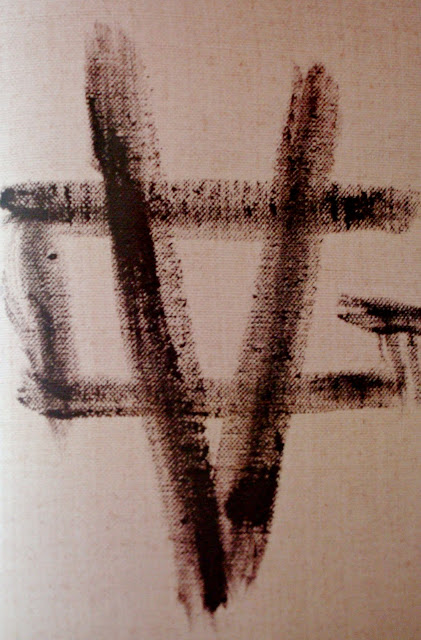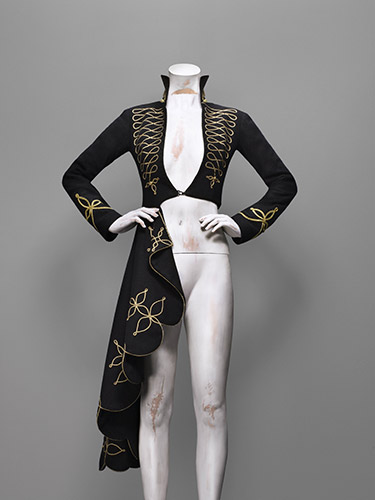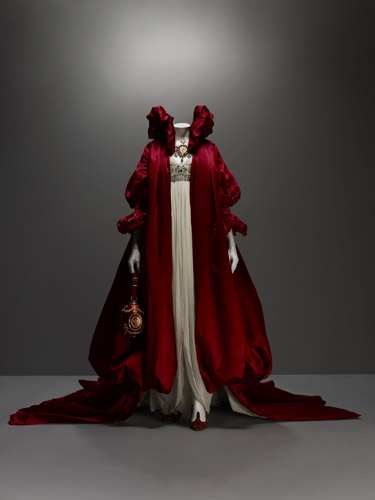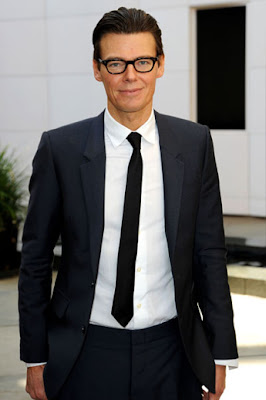I couldn't agree more with this statement.
I order books as often as I can; leaving them on loosely organized to-read piles only to languish as such for a good while. These are subdivided into the following: to read now, to read soon, to read later, to keep, and to read quickly and pass on. Aside from a few good pieces of furniture, dinnerware, sentimentoes, and wardrobe keepers, there are old books and magazines in storage, waiting to be read and reread. Some magazines are a few years old but I can't bear discarding until I've gone through them from cover to cover. I hope I'm not the only person who has this awfully long backlog around here. After an inspired design week in NYC recently, I took this long weekend to process the inspiration by delving into the latest coffee table book to arrive. I received the book before seeing the exhibit at the Metropolitan Museum but didn't open it. I knew that this would be a keeper and got some for my fashionista friends as gifts.

a tableau with my seed pearls and brass necklace
on the left skull
and the layered pearl and scrolled medallion necklace
my friend, Carla Herrera, made.
expressing a bit of romantic primitivism with
a carved boar tusk necklace
I love the vivid explosion of Spring interpreted in these S/S 2011 shoe collection by Sarah Burton. This was just how I felt while viewing the MET exhibit, awash with a sense of wonder and madness, shrouded in extreme light and darkness. The scope of his artistry was incredible and one doesn't really grasp its layers until you see all of it together in full force. I left wondering what could have been if he didn't leave too soon. But then maybe this is enough; he gave so much of himself in every creation.
McQueen's Autumn Winter 2010 Collection
the installation in the Romantic Gothic gallery
Dante, autumn/winter 1996–97 Black wool felt embroidered with gold bullion cord
From the collection of Isabella Blow courtesy of the Hon. Daphne Guinness
“I spent a long time learning how to construct clothes, which is important to do before you can deconstruct them.” Self Service, Spring/Summer 2002

Jacket of brown pony skin with impala horns; trousers of bleached denim
In McQueen’s Words
“The whole show feeling was about the Thomson’s gazelle. It’s a poor little critter—the markings are lovely, it’s got these dark eyes, the white and black with the tan markings on the side, the horns—but it is the food chain of Africa. As soon as it’s born it’s dead, I mean you’re lucky if it lasts a few months, and that’s how I see human life, in the same way. You know, we can all be discarded quite easily. . . . You’re there, you’re gone, it’s a jungle out there!”
McQueen quoted in Caroline Evans, Fashion at the Edge: Spectacle, Modernity and Deathliness (New Haven, Conn.: Yale University Press, 2002)
Supercalifragilisticexpialidocious, autumn/winter 2002–3
Coat of black parachute silk; trouser of black synthetic; hat of black silk satin
Hat by Philip Treacy for Alexander McQueen courtesy of Alister Mackie
Courtesy of Alexander McQueen
Photography by Sølve Sundsbø
In McQueen’s Words
“This collection was inspired by Tim Burton. It started off dark and then got more romantic as it went along.”
Numéro, July/August 2002
“Life to me is a bit of a [Brothers] Grimm fairytale.”
Reuters, February 2001

Red and black ostrich feathers and glass medical slides painted red
Courtesy of Alexander McQueen
Photography by Vogue
Andrew Bolton: This particular dress came from a collection called VOSS, which was all about beauty. And I think one of McQueen’s greatest legacies was how he would challenge normative conventions of beauty and challenge your expectations of beauty—what we mean by beauty. This particular one is made out of ostrich feathers dyed red. And the glass slides are actually microscope slides that have been painted red to give the idea of blood underneath. And there’s a wonderful quote in association with this dress, where he talks about how there’s blood beneath every layer of skin. And it’s an incredible, again, very powerful, powerful piece.
In McQueen’s Words
“There’s blood beneath every layer of skin.”
The Observer Magazine, October 7, 2001
Courtesy of Alexander McQueen
Photography by Vogue
Jacket of pink and gray wool bird’s-eye embroidered with silk thread; trouser of pink and gray wool bird’s-eye; hat of pink and gray wool bird’s-eye embroidered with silk thread and decorated with Amaranthus
In McQueen’s Words
“I want to be honest about the world that we live in, and sometimes my political persuasions come through in my work. Fashion can be really racist, looking at the clothes of other cultures as costumes. . . . That’s mundane and it’s old hat. Let’s break down some barriers.”
Nylon, February 2004
Irere, spring/summer 2003
Ivory silk organza, georgette, and chiffon
Andrew Bolton: One of the highlights in this gallery is a dress called the “Oyster” Dress, which is made up of hundreds and hundreds of layers of silk organza, almost like a mille-feuille pastry. And the collection told the story of a shipwreck at sea and the subsequent landfall in the Amazon, and it was peopled with pirates, conquistadors, and Amazonian Indians.
And I think that what’s interesting about this particular dress is you see how McQueen evolved as a designer in terms of the fact that he was always well known as a tailor. With this particular dress, you see a much softer approach. As Sarah Burton explains:
Sarah Burton: He wanted this idea of it—was almost like she drowned—and the top part of the dress is all fine boning and tulle, and the chiffon is all frayed and disheveled on the top. The skirt is made out of hundreds and hundreds of circles of organza. Then, with a pen, what Lee did was he drew organic lines. And then all these circles were cut, joined together, and then applied in these lines along the skirt. So you created this organic, oyster-like effect.
Andrew Bolton: He learned softness at Givenchy; he learned draping at Givenchy. And this particular dress, I think, is a real tour de force of the couture and is a great reference to the skills that McQueen learned at the ateliers at Givenchy.
“Working in the atelier [at Givenchy] was fundamental to my career . . . Because I was a tailor, I didn’t totally understand softness, or lightness. I learned lightness at Givenchy. I was a tailor at Savile Row. At Givenchy I learned to soften. For me, it was an education. As a designer I could have left it behind. But working at Givenchy helped me learn my craft.”
Purple Fashion, Issue 7, Summer 2007
Lilac leather and horsehair
Courtesy of Alexander McQueen
Photography by Vogue
"He knew exactly what he wanted, and he knew exactly what he saw didn’t look right on you, and what he wanted on you. So fittings were very . . . they weren’t long and exhausting at all. They were quick. I love when someone just knows and tells you from A to Z exactly what they want. I love that.
I know his looks when I was watching—as a spectator watching the show; they were drastic with women. A lot of people thought, “Oh, he doesn’t like women.” But it’s not true; Lee loved women. It’s just a show. It’s a performance. Those were the most terrifying shows to do as a model but then, after, the most fun because you pushed yourself to do something out of your comfort zone, you know?"---Naomi Campbell
“[In this collection] the idea of the chess game meant that we looked at six different types of women, women on opposing sides. We had the Americans facing the Japanese and the redheads facing the tanned Latinos.”
Another Magazine, Spring/Summer 2005
Cream silk tulle and lace with resin antlers
Courtesy of Alexander McQueen
Photography by Vogue
In McQueen’s Words
“When we put the antlers on the model and then draped over it the lace embroidery that we had made, we had to poke them through a £2,000 piece of work. But then it worked because it looks like she’s rammed the piece of lace with her antlers. There’s always spontaneity. You’ve got to allow for that in my shows.” Big, Autumn/Winter 2006
Nude silk organza embroidered with silk flowers and fresh flowers
Courtesy of Alexander McQueen
Photography by Vogue
this was one of my favorite collections of all time
see an old blog post here
The Girl Who Lived in the Tree, autumn/winter 2008–9
Coat of red silk satin; dress of ivory silk chiffon embroidered with crystal beads
Courtesy of Alexander McQueen
Photography by Sølve Sundsbø
Andrew Bolton: This crimson coat and delicate empire-waist dress culminated a collection from 2008–9, inspired by the queens of England. As Sarah Burton explains:
Sarah Burton: It’s an enormous volume of fabric that at the neck is all bulleted and at the hem is all bulleted. But although it’s duchess satin, it still appears very light. And I think he wanted this sort of, you know, this regality but a lightness to it.
Andrew Bolton: The collection, called The Girl Who Lived in the Tree, was dreamy and romantically nationalistic, albeit tinged with irony. Sam Gainsbury produced the runway show for the collection, which featured an enormous tree wrapped in transparent grey silk: Sam Gainsbury: Mostly Lee would have a very clear idea of who the girl was, and then from that point he would decide where she was, and then he’d decide what she was wearing. He had an amazing tree in his garden in Fairleigh, in his country house, and this tree had always fascinated him. So for me it was about the beauty and the power of this tree.
Andrew Bolton: McQueen conceived a fairy tale about a girl who dressed in beautiful black rags—presented during the first half of the show. When she met her prince, she descended from her tree, and her wardrobe exploded with the color, opulent materials, and jewels you see here.
In McQueen’s Words
“I don’t really get inspired [by specific women]. . . . It’s more in the minds of the women in the past, like Catherine the Great, or Marie Antoinette. People who were doomed. Joan of Arc or Colette. Iconic women.” Purple Fashion, Summer 2007

The Horn of Plenty, autumn/winter 2009–10
Black duck feathers
Courtesy of Alexander McQueen
Photography by Sølve Sundsbø
One of the most compelling items in this particular gallery is an ensemble that’s made out of duck feathers dyed black, which gives the impression of a raven. A raven was a Romantic symbol of death. It’s an item that’s very melancholic but also very romantic at the same time. It came from a collection called The Horn of Plenty. And The Horn of Plenty was a collection that was very much inspired by the 1950s haute couture. And you even see the silhouette here; you see the very nipped-in waist, the huge shoulders. McQueen loved a very hard shoulder and a very small waist. So even in this particular garment—even though it seems so extreme—he’s still referencing 1950s couture. He’s still playing with the proportions that he loved so much. And feathers play such an important role in McQueen’s work. He loved birds. And feathers was a material that he would revisit again and again in his work.
In McQueen’s Words
“It is important to look at death because it is a part of life. It is a sad thing, melancholy but romantic at the same time. It is the end of a cycle—everything has to end. The cycle of life is positive because it gives room for new things.” Drapers, February 20, 2010
Jellyfish
Plato’s Atlantis, spring/summer 2010
Dress, leggings, and “Armadillo” boots embroidered with iridescent enamel paillettes
Sarah Burton: I think with Plato’s Atlantis, it was real perfection the way he executed every single piece. But knowing Lee, he would have probably gone somewhere completely different after Angels and Demons. He would always surprise you, and that was the joy of working with him, is he would always take it somewhere that was unexpected. Every time he would take up a different theme or a different angle or a different technique and he would always push it forward, like, relentlessly pushing forward. And you could never really predict what he was going to do because he was so much his own person. His vision was so pure. And he was really funny, and he was really good fun to work for. And, you know, he was incredibly loyal and incredibly inspiring.
Andrew Bolton: McQueen once remarked, “I’m overly romantic,” but it was precisely his romantic yearnings that propelled his creativity and advanced fashion in directions previously considered unimaginable.
“[This collection predicted a future in which] the ice cap would melt . . . the waters would rise and . . . life on earth would have to evolve in order to live beneath the sea once more or perish. Humanity [would] go back to the place from whence it came.”
Plato’s Atlantis (spring/summer 2010) program notes
“There is no way back for me now. I am going to take you on journeys you’ve never dreamed were possible.” WWD, February 12, 2010

Cabinet of Curiosities gallery
balsa wood skirt
1999
Alexander McQueen
Andrew Bolton
curator of the exhibition
To McQueen who considered himself an artist,
fashion is just the medium.
He believed that fashion should touch you emotionally.
He felt that deeply, deeply, deeply.
text about the clothes are copied verbatim from here the exhibition has been extended. click here for details





























































